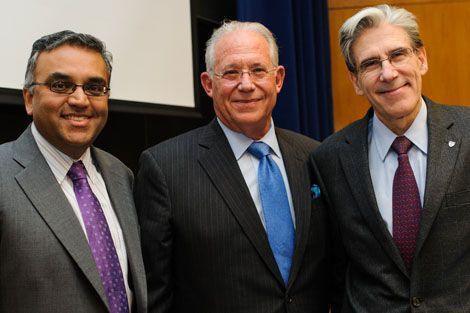January 28, 2014 — The United States could learn a thing or two from Singapore when it comes to providing quality health care at reasonable cost, according to biologist, entrepreneur, and author William Haseltine.
Intrigued by the fact that the Southeast Asian nation spends only 3% of its GDP on health care in contrast to the United States’ nearly 18%—yet has a healthier population—Haseltine, president and founder of the think tank ACCESS Health International, examined Singapore’s approach to health care in his 2013 book, Affordable Excellence: The Singapore Health Story.
He thinks that Singapore’s emphasis on “social harmony”—on ensuring that everything in society works well and smoothly—is a key factor in that nation’s health care achievements. “They believe that nobody in their country, even a foreigner, will go without health care,” Haseltine said during a January 15, 2014 talk at Harvard School of Public Health (HSPH), where he served as a professor from 1976-92. “If they have to put more money into it to help to help the vulnerable population and the very old population, they do it.”
Haseltine gave a Centennial Dean’s Distinguished Lecture Book Presentation to a standing-room-only audience in Kresge G-2. HSPH Dean Julio Frenk introduced Haseltine as “a Renaissance person”—an accomplished basic researcher in HIV/AIDS, cancer, and genomics; an innovator who founded several successful biotechnology companies; and a researcher of health systems.
Faculty speaker Ashish Jha, professor of health policy and management at HSPH, acknowledged that there are major differences between the U.S. and Singapore. Singapore is tiny in comparison, with roughly the same size population as Massachusetts, and its government intervenes in the economy and society much more so than the U.S. government. But there are still lessons to learn from Singapore “that are pertinent, that are relevant, that are completely on point with the issues that America is struggling with today,” Jha said. He cited, for example, Singapore’s emphasis on both the value of a free market system and the value of a strong government role in the marketplace to ensure a well-functioning health care system.
Singapore has a range of policies that support health care, Haseltine said. For example, Singaporeans are required to have a health savings plan, called Medisave, that works like a 401K retirement savings plan in the U.S; the government sets both policies and prices for private insurance companies; health care costs for services and procedures must be completely transparent; there’s a minister of “wellness” who emphasizes the importance of a healthy diet and exercise and works to curb smoking; there are high health care subsidies for those with low incomes; and the government invests heavily in medical education.
There’s also a compulsory savings program for workers called the Central Provident Fund that can be used to pay for housing; as a result, 85% of Singaporeans own their own home. “That is a big social stabilizer, and a big stabilizer of health,” Haseltine said.
Haseltine acknowledged that the Singapore government’s heavy hand in the marketplace and in society wouldn’t go over well in the U.S. But he thinks that some health care ideas from Singapore could work here, such as mandatory health savings accounts, greater transparency about costs and prices, and more regulation of insurance company prices and policies.
Sometimes, Haseltine said, the right government policy can have a positive impact. “We have this whole suspicion of government, but that’s a really big mistake,” he said. Trusting the government to set enlightened policy is a big lesson the U.S. can learn from Singapore, he said.
photo: Aubrey Calo
